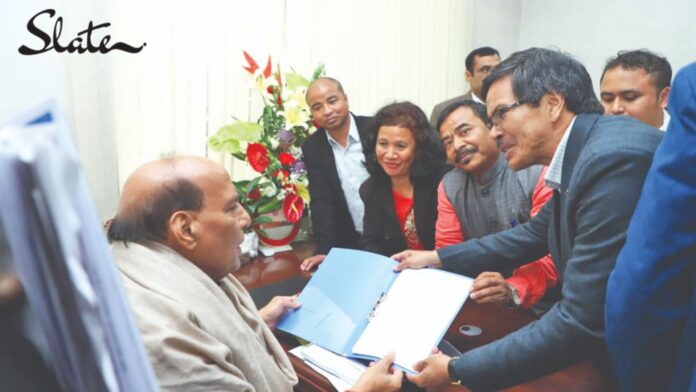By Babul Dkhar
Once inside the premises of U Soso Tham (formerly, State Central Library), curious onlookers exploring the area will notice a building, on the way to the Directorate of Arts and Culture, Meghalaya. Written on the wall outside is Ka Ophis Jong Ka: Khasi Authors’ Society, with the address and the year of establishment.
However, it is a particular sentence that catches the attention: Tien Phira: “Pynniar ia ka ktien Khasi”, meaning, “Slogan: To spread the Khasi language”, providing a glimpse of the aim of the Khasi Authors Society (KAS) or Ka Seng ki Nongthoh Kot.
The KAS, under its umbrella, has embraced all the Khasi writers. Not only do they encourage each other to write in their mother tongue, but collectively work to find out ways and means to write on issues pertaining to the Khasi culture and society, including language.
Formed on September 11, 1979, the KAS also publishes journals – Ka Thiar Ki Nongthoh and Ka Syngkhong Jingtip.
“Through these journals, our writers are contributing to spreading the Khasi language and its literature,” Prof. DRL Nonglait, the KAS president said, adding how Khasi writers cover a wide range of subjects from social science, geography and law to environment and science. They also organise seminars and conferences where experts are invited to give lectures on various topics.
He added how the organisation gives awards to students who perform well in class 10 and 12 board examinations, including the masters (or MA) level, with the aim to encourage students to immerse themselves in and take up the language further.
Along with the preservation of the language, they also work to protect the indigenous people.
The demand to include Khasi in the Eighth Schedule of the Constitution has been there since 1980, with people like HW Sten and Prof RS Lyngdoh taking up the inclusion of the language in the said schedule during the initial years. “After the formation of the Khasi Authors Society (L) Prof. RS Lyngdoh, as a member of the Sahitya Akademi, took up the issue of including Khasi in the Eighth Schedule of the Constitution before the Akademi.”
Back in the day, the Akademi was one of the agencies that studied languages and whether they were fit to be included in the Eighth Schedule and recognised by the government of India.
1992 proved to be a turning point when Manipuri and Nepali were included in the Schedule. Its impact was felt in the state as the demand to include Khasi gained momentum and was raised in Parliament. “The then Shillong Member of Parliament aggressively raised the issue,” he said.
The next momentous event came in 2003 when Bodo and Santhali languages were recognised in the Eighth Schedule. Once again, the issue was raised in Parliament.
The president of KAS emphasised how Santhali and Khasi come from the same Mon-Khmer group of language families. “From the Mon-Khmer group of language family, Khasi and Santhali belong to the Austro-Asiatic language family.”
So far, only Santhali is included in the Eighth Schedule of the Constitution from the Austro-Asiatic language family. This inclusion is particularly important, as it has paved the way to include Khasi. That the language movement in the state has now received wider national attention has, therefore, been a defining moment for the decades-long fight.
Nonglait adds, “We have documented most of the books written by Khasi authors”, and the list is with the Directorate of Arts and Culture. He further stated how they’re chronicling evidence to justify the inclusion of the language in the Eighth Schedule of the Constitution. Since 2013, the Ministry of Home Affairs (MHA) has asked the state government for information on the significance of the Khasi language.
“Since that year, the government of Meghalaya had sent all information to the Home Ministry. Exchange of letters and information between the state government and the MHA was exclusively for Khasi.”
In 2005, the language was granted the status of “Associate Official Language” of Meghalaya, through state legislation. Nonglait credits DD Lapang, then chief minister for taking up the issue and demanding that Khasi be included in the Schedule, adding how it came before any other language of the state.
In 2018, the KAS began to press for the early materialisation of the long pending demand and organised a rally in Shillong, where about 1000 citizens of the state participated, culminating in the November 27 unanimous resolution to urge the Centre to include Khasi and Garo languages in the Eighth Schedule of the Constitution.
The resolution further highlighted how the Khasi language had its written script since 1842 through the adoption of the Roman alphabet, as introduced by Thomas Jones with the help of Donrai and Junkha, the Khasi literates of that time. In this context, it becomes important to know about the course on computer concepts in the Khasi language launched by the Meghalaya government on September 21, 2012, which aimed at introducing Khasi lingual into present-day technology and information.
Khasi language has been a subject for higher studies at Calcutta University and Gauhati University during the pre- and post-independence period, and at the North-Eastern Hill University up to PhD level.
In March 2019, the state government and KAS received a letter from the centre, which stated that the Khasi language is already on the list with 38 others, awaiting recognition in the Eighth Schedule. Considering Khasi is widely spoken in Meghalaya and in parts of Assam and Bangladesh, it is about time that the language gets its desired recognition. According to the 2011 census, 14,31,344 people in India speak the language.
Speaking to Prof. Nonglait, one gets an idea of a passion, birthed in realising the importance of preservation of an indigenous language. Self-awareness and consistency remain key features of the language movement in Meghalaya.


